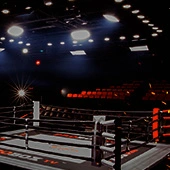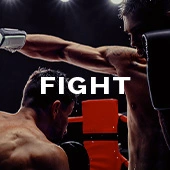by David P. Greisman
Floyd Mayweather’s move to Showtime last year was seen as a big victory for the network and a big blow for HBO, which had previously been the longtime home to one of the best boxers around. It was indeed a publicity coup for Showtime, but in reality the supposedly industry-changing announcement was rather a reflection of an industry that had already changed.
Here, briefly, is what I wrote on the subject last year:
“There once was a time that Showtime seemed to settle into the dichotomy of it being second-place to HBO. It was HBO that lured former Showtime fighters over. It was HBO that carried the prestige of being the pinnacle for prizefighters. It was HBO that had the biggest audience and the biggest paychecks. Showtime, meanwhile, marketed itself as catering to the hardcore boxing fans — its philosophy was ‘Great fights. No rights.’
Showtime executive Stephen Espinoza came out swinging, and spending. That was noticeable as more Golden Boy boxers — including some who had been groomed and featured on HBO — appeared on Showtime. There were more tripleheaders and quadrupleheaders. There were preliminary bouts aired on a sister network prior to the main broadcasts. There was the arrival of former ‘Friday Night Fights’ host Brian Kenny, now serving as emcee for Showtime, giving its shows more of a big-event feel.
“Business otherwise continued on as usual for HBO; it still made fights, including some involving Golden Boy and Haymon fighters. What Showtime’s moves did was establish perception as reality. More boxers would jump at the money being offered to fight on that network. More fans would see a need to subscribe not just to one premium cable outlet that airs The Sweet Science, but two. HBO wasn’t just facing a competing programmer, but a competing bidder. A planned rematch between Victor Ortiz and Andre Berto went to Showtime. So did Canelo Alvarez. And so, eventually, did Mayweather.”
Bringing this conversation back to the present means we need to begin with late last week, when the announcement went out that HBO would be airing a fall fight between light heavyweight titleholders Bernard Hopkins and Sergey Kovalev.
It was a big announcement, albeit one that was far less of a publicity coup than Mayweather’s move. Still, some will view it as a victory for HBO over Showtime — boxing is a one-on-one sport, after all, and we like to see the boxing business as being the same way.
As with last year with Mayweather, the making of Hopkins vs. Kovalev needs to be looked at within a grander context.
The reason why people are making a big deal of Hopkins-Kovalev is because of a story that has been recounted plenty of times over the past half a year. When 2014 began, HBO was planning to feature Kovalev and lineal light heavyweight champion Adonis Stevension in separate bouts before pairing the two power-punching 175-pounders in a fight later in the year.
HBO and Kovalev’s promoter, Main Events, contend that a deal had been agreed upon. Stevenson’s team disputes that. And when Stevenson sought more money from HBO for his keep-busy fight against Andrzej Fonfara without guaranteeing that he would face Kovalev next, the network balked. Showtime stepped in with a bid, acquiring the right to air Stevenson-Fonfara.
HBO aired the mismatch between Kovalev and Cedric Agnew in March, and many wondered whether Kovalev would be left without a big fight. After all, logic dictated that Stevenson’s move to Showtime would likely lead to a bout with Hopkins. Stevenson, Hopkins and others essentially confirmed as much.
Stevenson had Fonfara down and reeling in the first half of their bout this past May. Fonfara battled back, hurt Stevenson and scored a knockdown of his own. Unlike Kovalev-Agnew, the Stevenson-Fonfara bout had been expected to be fun for as long as it lasted. Few had expected it to be as competitive as it was; it was a very good fight. Stevenson won a decision, and people waited for the Hopkins fight to be announced.
It wasn’t. Two months and a week after Stevenson-Fonfara came the word that Hopkins would be facing Kovalev on HBO instead.
Back in April, Hopkins made it sound as if such a fight were highly unlikely.
“I’m a Showtime fighter. I’m loyal to Showtime. I’m loyal to Richard Schaefer. I’m loyal to Al Haymon,” Hopkins told reporters shortly after his unification win over Beibut Shumenov. “Unless Kovalev comes here or crosses the street…”
Schaefer was at the time still the CEO of Golden Boy Promotions, of which Hopkins is a shareholder. Haymon is a longtime friend of Hopkins; he does not have Hopkins as a client, but he does work with Stevenson.
Hopkins has his beliefs for why the Stevenson deal didn’t come together. He went into them in a conversation with BoxingScene.com’s Rick Reeno that can be found here: http://bit.ly/hopkinscheckmate
It is a reversal of fortunes compared with earlier in the year. Back then, HBO had paid for a spotlight fight in Kovalev-Agnew and looked as if it would not have a major bout for Kovalev later in the year. Now it is Showtime that paid for Stevenson-Fonfara, getting an entertaining fight out of it, though not the subsequent major bout in which it had been investing.
Let’s not overstate this, though. HBO is getting one particular big fight. Showtime isn’t. That is all that should be concluded for the moment.
Hopkins could conceivably beat Kovalev and then have his next bout be back on Showtime against Stevenson or another opponent. Hopkins could beat Kovalev and then retire. Stevenson, meanwhile, could “keep busy” with a major Montreal event on Showtime against, say, former 175-pound champion Jean Pascal.
Yes, it is notable that Hopkins, who was the last Golden Boy fighter to be on HBO in 2013, will be the first to be back on the network. But again, this reality is a reflection of an industry that had already changed. Schaefer’s departure from Golden Boy came as Oscar De La Hoya asserted control over his namesake company, making amends with rival promoter Top Rank and saying he would work with Bob Arum again and also with HBO in order to make the biggest fights for boxing fans.
Hopkins-Kovalev is just one fight. Golden Boy and Showtime still have a business relationship. Showtime will continue to work to be seen as one of two broadcasters of big boxing matches in the United States.
Mayweather’s move last year didn’t make Showtime or break HBO. Hopkins-Kovalev’s true significance is in what it means in the moment: a unification bout involving two fighters who hold three of the world titles at 175 pounds, a fight that leaves Stevenson waiting a little bit longer for one or the other.
Boxing is a one-on-one battle, and we tend to see the business as being similar. The rivalry between promoters Bob Arum and Don King eventually gave way to Top Rank vs. Golden Boy. We look at boxing broadcasting as being HBO vs. Showtime.
Such battling may be the motivating attitude for the promoters and networks, but we fans and observers shouldn’t be rooting for someone to be victorious and the other to be defeated. As interesting as the above storylines are, it does us no good if a promoter or network is struggling or if a big-name boxer is left without a viable opponent.
That doesn’t mean competition is bad. WCW, once second-place to the WWF just as Showtime was to HBO, rose to the top of pro wrestling in the 1990s with its compelling storylines and major signings. That ascent, in turn, led to the arrival of the game-changing “Attitude Era” in WWF (now WWE). Both companies flourished for a time until mismanagement led to the fall of WCW.
Competition can be a good thing when it means a better product for the fans. What we should want, then, is for all of us to come out as winners.
The 10 Count
1. Daniel Geale, with the extra-long first round, lasted a total of 9 minutes and 47 seconds against Gennady Golovkin.
Blake Caparello, who probably wished there had been an extra-short second round, lasted a total of 4 minutes and 47 seconds against Sergey Kovalev.
2. Drug testing, part one: Last week’s media conference call with welterweight titleholder Shawn Porter and challenger Kell Brook included questions about the drug testing for their bout, which had not yet started at that point despite the bout being just weeks away. (It’s apparently since begun)
You’d know this if you were a media member on the call or had listened to the recording that Golden Boy Promotions sent out of it. But if you read one of those websites that merely posts the emailed transcript, or looks through the emailed transcript for quotes to use in articles, then you wouldn’t see a single mention of drug testing.
I don’t know why the publicists who put the transcript together would omit such a thing. It was an important question. And while the situation isn’t a flattering one, it doesn’t look good at all to seemingly try to sweep an important topic underneath the proverbial rug.
Drug testing is something that this sport of ours needs to do more to confront. It shouldn’t be treated as an annoyance; the conversation shouldn’t be avoided.
3. Drug testing, part two: And that’s why I was disappointed with the answer that Kathy Duva of Main Events gave when asked this past weekend about whether there would be more stringent drug testing for the fight between Bernard Hopkins and Sergey Kovalev.
“I think that commissions have to take the lead in that. I don’t necessarily believe that it’s up to boxing promoters to regulate. I think it’s a bad, bad way to go,” she said.
But the commissions aren’t taking the lead. This sport has done very little to move ahead with better drug testing in recent years despite the cases of high-profile boxers testing positive, despite the increasing awareness of doping in sports as a whole, and despite the regular acknowledgement of how weak and rare testing in boxing continues to be.
Boxing’s decision-makers seem like as if they would rather assume that athletes are clean, or they just don’t care whether athletes are dirty. After all, a fighter who tests positive could lead to the cancellation of a card, loss of money, the ruining of an investment, and the souring of relationships with fans, sponsors, venues and networks.
It wasn’t right for Major League Baseball to turn a blind eye for the sake of money, though. And it definitely isn’t right for boxing to continue to move slower than a snail’s crawl. As others have said time and again, this isn’t about hitting a ball. This is about hitting another person.
4. The number of people watching Gennady Golovkin fight on HBO had been increasing with each performance. That’s no longer the case. Rather, there was a significant drop for his July 26 victory over Daniel Geale.
Here’s the rundown of his HBO ratings:
- Golovkin’s HBO debut, against Gregorz Proksa in September 2012, pulled in an average of 685,000 viewers, according to Nielsen ratings.
- Golovkin vs. Gabriel Rosado pulled in 813,000 viewers in January 2013.
- Golovkin vs. Matthew Macklin pulled in 1.1 million viewers in June 2013.
- Golovkin vs. Curtis Stevens pulled in 1.4 million viewers in November 2013.
- Golovkin vs. Geale averaged 984,000 viewers.
HBO executives found the number disappointing, while still pointing to a number of reasons they felt could’ve been a factor. Among them: that Golovkin had not fought on the network in nearly nine months; that overall July television viewership is lower than, say, November’s; and that the fight was so short and thus unable to build an audience.
But plenty of fighters have been out for about nine months and returned to get good ratings. And there have been July broadcasts on HBO that have done better than this, including Paul Williams vs. Erislandy Lara (July 2011, 1.116 million), Amir Khan vs. Zab Judah (July 2011, 1.417 million), Nonito Donaire vs. Jeffrey Mathebula (July 2012, barely better at 988,000), Amir Khan vs. Danny Garcia (July 2012, 1.255 million), Adrien Broner vs. Vicente Escobedo (July 2012, 1.369 million).
Others have said that this rating might be due to a lack of familiarity with Geale, who had only appeared on HBO once before; or due to this being a standalone date on HBO without any recent lead-in marketing on other boxing broadcasts; or due perhaps to the publicity and marketing efforts from the promoters and fighters’ teams; or the lead-in fight between Bryant Jennings and Mike Perez; or even the lead-in movie aired before the boxing broadcast began.
In the grand scheme, we just don’t know, and we can’t know. All we do know is what Golovkin’s number was, and what it means.
What it means is that HBO is no longer likely to pay for Golovkin to fight, say, fellow titleholder Sam Soliman on the network. Instead, this rating means Golovkin will end up being back in with a more familiar name who could help draw a bigger audience.
And what we should realize is that boxing still has a ridiculously small audience in the United States for even its more notable names.
5. Andre Dirrell did indeed appear on last week’s undercard of ESPN2’s “Friday Night Fights,” making easy work of Vladine Biosse.
He still has the physical tools to make for potentially interesting fights with several names at and around 168. I’d love to see Dirrell finally face Andre Ward — or have rematches with Carl Froch and Arthur Abraham, or even take on George Groves.
Dirrell’s career has been a punch line for the past several years thanks to his inactivity and mismanagement. Despite that, it could be really good to have him back in the ring.
6. Boxers Behaving Badly, part one: Boxing brothers Liam and Stephen Smith were arrested in late July and accused of assault following a fight in the street that left one man injured outside of a gay nightclub in Liverpool, according to the Daily Mirror. A third man was also arrested. All are out on bail, the newspaper said.
“There was a fight last night, me and Liam were there. Neither of us hit anyone,” Stephen Smith wrote on Twitter on July 28. He soon added: “We weren't fighting with anyone, never mind a gay lad.”
Liam Smith tweeted: “For the record, there was a fight, we was there an got arrested, never threw a punch, never took a punch. The fight wasn't gays either.”
Liam, a 26-year-old junior middleweight, is 17-0-1 with 7 KOs and is coming off a sixth-round knockout of Jason Welborn in a bout that took place on the same day as the alleged brawl. Stephen, a 29-year-old junior lightweight, is 20-1 with 1 KO and is coming off an eight-round points won on July 12 over Pedro Navarrete.
7. Boxers Behaving Badly, part two: Retired heavyweight Chris Burton is one of a group of men being accused of kidnapping and false imprisonment, according to an article by British newspaper The Northern Echo that was otherwise very short on details.
Burton, 33, was a heavyweight for much of his pro career, which began in 2005. He won his first 11 fights before getting stopped by Sam Sexton in the final of a 2008 installment of the one-day “Prizefighter” tournaments. His last bout came in 2012, which he lost by second-round technical knockout to drop to 15-2 with 6 KOs.
8. Boxers Behaving Badly, part three: Lee McCallister, a former lightweight and junior lightweight boxer from Scotland, is facing a charge of vandalism after allegedly breaking the window of a vehicle, according to the Evening Express.
McCallister fought from 2002 to 2013, capturing some regional titles and putting together a record of 35-3 with 9 KOs. Two of those defeats came via stoppages when he stepped up against a pair of familiar names — John Murray (who would go on to lose to Brandon Rios) and Denis Shafikov (who earlier this year lost to lightweight titleholder Miguel Vazquez).
9. Boxers Behaving Badly, part four: Adam Forsyth: A former Australian Olympian will spend two years behind bars for lying during an investigation into organized crime, according to Perth Now.
Forsyth, 33, “pleaded guilty to six counts of giving false or misleading evidence,” the article said.
A few years back Forsyth was sentenced to community service after assaulting a man in a nightclub who had allegedly stolen a $450 bottle of champagne from a group that included Forsyth, according to an article at the time in Western Australia newspaper The Sunday Times.
Forsyth fought at heavyweight in the 2004 Olympics — which is the cruiserweight limit in the professional ranks — losing in the quarterfinals. As a pro, he was 10-0 with 8 knockouts, his last bout coming in June 2011.
10. A quick correction: An early edition of last week’s “Fighting Words” had an error in The 10 Count. I mistakenly wrote that Roy Jones had only scored two knockouts in the last decade (and three dating back to 2002). That was incorrect. Jones has scored three knockouts in the past decade and four dating back to the 2002 win over Clinton Woods. I hadn’t included Jones’ victory over Jeff Lacy in 2009. (The others are Omar Sheika in 2009 and Courtney Fry just the other week.)
Jeremy Foley of the Pound 4 Pound Ireland boxing blog went for the low-hanging fruit in pointing out my error:
“Y’all Musta Forgot,” he wrote.
“Fighting Words” appears every Monday on BoxingScene.com. Pick up a copy of David’s new book, “Fighting Words: The Heart and Heartbreak of Boxing,” at http://bit.ly/fightingwordsamazon or internationally at http://bit.ly/fightingwordsworldwide . Send questions/comments via email at fightingwords1@gmail.com



